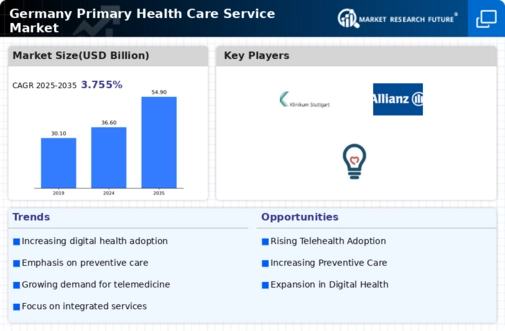Government Initiatives and Funding
Government initiatives play a pivotal role in shaping the primary health-care-service market in Germany. The federal government has committed to increasing health-care funding, with an allocation of approximately €50 billion for health services in 2025. This funding is aimed at improving infrastructure, expanding access to care, and enhancing the quality of services provided. Additionally, policies promoting preventive care and early intervention are likely to reduce long-term health-care costs. The government's focus on integrating health services and improving care coordination is expected to foster a more efficient primary health-care system. These initiatives may lead to increased patient satisfaction and better health outcomes, thereby driving demand in the primary health-care-service market.
Rising Health Awareness Among Consumers
There is a noticeable increase in health awareness among consumers in Germany, which is significantly impacting the primary health-care-service market. As individuals become more informed about health issues and preventive measures, they are more likely to seek regular check-ups and screenings. This trend is reflected in the rising participation rates in preventive health programs, with an estimated 40% of the population engaging in regular health assessments by 2025. The growing emphasis on wellness and preventive care is prompting health-care providers to adapt their services accordingly. This shift not only enhances patient engagement but also encourages a proactive approach to health management, ultimately driving growth in the primary health-care-service market.
Increased Focus on Mental Health Services
The increasing recognition of mental health as a crucial component of overall health is driving changes in the primary health-care-service market. In Germany, mental health issues affect approximately 30% of the population at some point in their lives, leading to a growing demand for mental health services. The government has initiated programs to integrate mental health care into primary health services, promoting a holistic approach to health. By 2025, it is anticipated that mental health services will account for a larger share of primary health-care expenditures, reflecting the importance of addressing mental well-being alongside physical health. This focus on mental health is likely to enhance the overall effectiveness of primary health care, thereby influencing market dynamics.
Technological Advancements in Health Care
Technological advancements are significantly influencing the primary health-care-service market in Germany. Innovations such as telemedicine, electronic health records, and mobile health applications are transforming how health care is delivered. In 2025, it is estimated that around 30% of consultations in primary care will be conducted via telehealth platforms. These technologies not only improve patient access to care but also enhance the efficiency of health-care delivery. Furthermore, the integration of artificial intelligence in diagnostics and treatment planning is expected to streamline operations and reduce costs. As these technologies become more prevalent, they are likely to drive growth in the primary health-care-service market, enabling providers to offer more personalized and effective care.
Aging Population Demands Enhanced Services
The aging population in Germany is a critical driver for the primary health-care-service market. As the demographic shifts, the proportion of individuals aged 65 and older is projected to reach approximately 22% by 2030. This demographic change necessitates an increase in health-care services tailored to chronic conditions prevalent among older adults. Consequently, health-care providers are likely to expand their offerings, focusing on geriatric care and rehabilitation services. The demand for home health care services is also expected to rise, as many elderly individuals prefer to receive care in their own homes. This trend indicates a potential increase in investments in primary health-care services, which could enhance accessibility and quality of care for the aging population.














Leave a Comment